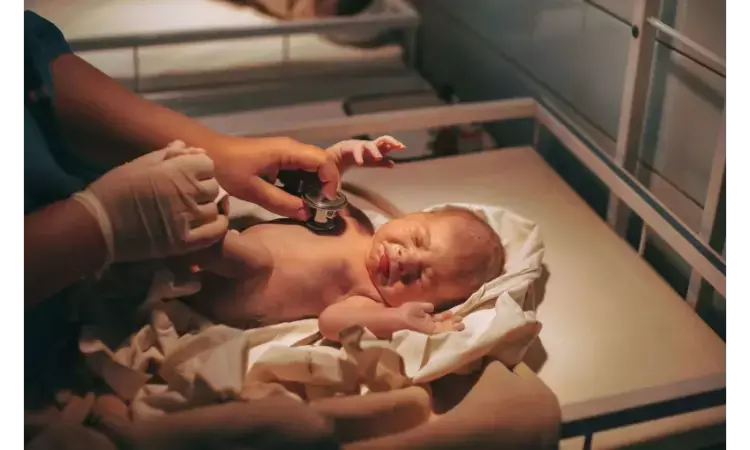- Home
- Medical news & Guidelines
- Anesthesiology
- Cardiology and CTVS
- Critical Care
- Dentistry
- Dermatology
- Diabetes and Endocrinology
- ENT
- Gastroenterology
- Medicine
- Nephrology
- Neurology
- Obstretics-Gynaecology
- Oncology
- Ophthalmology
- Orthopaedics
- Pediatrics-Neonatology
- Psychiatry
- Pulmonology
- Radiology
- Surgery
- Urology
- Laboratory Medicine
- Diet
- Nursing
- Paramedical
- Physiotherapy
- Health news
- Fact Check
- Bone Health Fact Check
- Brain Health Fact Check
- Cancer Related Fact Check
- Child Care Fact Check
- Dental and oral health fact check
- Diabetes and metabolic health fact check
- Diet and Nutrition Fact Check
- Eye and ENT Care Fact Check
- Fitness fact check
- Gut health fact check
- Heart health fact check
- Kidney health fact check
- Medical education fact check
- Men's health fact check
- Respiratory fact check
- Skin and hair care fact check
- Vaccine and Immunization fact check
- Women's health fact check
- AYUSH
- State News
- Andaman and Nicobar Islands
- Andhra Pradesh
- Arunachal Pradesh
- Assam
- Bihar
- Chandigarh
- Chattisgarh
- Dadra and Nagar Haveli
- Daman and Diu
- Delhi
- Goa
- Gujarat
- Haryana
- Himachal Pradesh
- Jammu & Kashmir
- Jharkhand
- Karnataka
- Kerala
- Ladakh
- Lakshadweep
- Madhya Pradesh
- Maharashtra
- Manipur
- Meghalaya
- Mizoram
- Nagaland
- Odisha
- Puducherry
- Punjab
- Rajasthan
- Sikkim
- Tamil Nadu
- Telangana
- Tripura
- Uttar Pradesh
- Uttrakhand
- West Bengal
- Medical Education
- Industry
Serial Head Circumference Measurements may help classify Microcephaly

In a recent study found the significance of monitoring newborns' head circumference (HC) not only at birth but also on their third day of life (DOL3). The findings published in the BMC Pediatrics have important implications for the diagnosis of microcephaly, reveal that measuring the maximum occipitofrontal circumference only once at birth or within 24 hours after birth may lead to misclassifications.
The study included 1131 live births with a gestational age of more than 27 weeks. Trained personnel used non-elastic tape measures to record HC measurements at birth or within the first 24 hours and again on DOL3 before the newborns were discharged. The World Health Organization (WHO) and Fenton Growth Charts served as reference ranges for interpreting the data for full-term and preterm neonates, respectively.
Paired sample t-test analyses demonstrated a statistically significant increase in HC when measured on DOL3 compared to measurements taken at birth or within the first 24 hours. On average, there was a 0.17 cm increase, emphasizing the need for ongoing monitoring during the critical early days of life.
Furthermore, 32 newborns initially fell below the third percentile (< P3) for HC at birth. However, 25 of these infants exhibited HC measurements equal to or above the third percentile on DOL3. This suggests that classifying microcephaly based solely on initial measurements may be misleading.
The study also examined factors associated with increased HC on DOL3. Newborns whose mothers experienced labor pains showed an average HC increase of 0.31 cm at DOL3. Additionally, infants who were symmetrically or asymmetrically small-for-gestational age (SGA) had significantly increased HC on DOL3, with average increases of 0.59 cm and 0.37 cm, respectively. Parity and gestational age, however, did not show a significant association with HC changes.
The study underscores the importance of serial HC measurements on DOL3 or before a newborn's discharge. These findings could have far-reaching implications for the early detection and classification of congenital microcephaly, ensuring that infants with this condition receive timely and appropriate care.
Reference:
Sengasai, C., Chokephaibulkit, K., Plipat, N., & Wongsiridej, P. (2023). Serial head circumference measurements should be used to classify congenital microcephaly. In BMC Pediatrics (Vol. 23, Issue 1). Springer Science and Business Media LLC. https://doi.org/10.1186/s12887-023-04315-4
Neuroscience Masters graduate
Jacinthlyn Sylvia, a Neuroscience Master's graduate from Chennai has worked extensively in deciphering the neurobiology of cognition and motor control in aging. She also has spread-out exposure to Neurosurgery from her Bachelor’s. She is currently involved in active Neuro-Oncology research. She is an upcoming neuroscientist with a fiery passion for writing. Her news cover at Medical Dialogues feature recent discoveries and updates from the healthcare and biomedical research fields. She can be reached at editorial@medicaldialogues.in
Dr Kamal Kant Kohli-MBBS, DTCD- a chest specialist with more than 30 years of practice and a flair for writing clinical articles, Dr Kamal Kant Kohli joined Medical Dialogues as a Chief Editor of Medical News. Besides writing articles, as an editor, he proofreads and verifies all the medical content published on Medical Dialogues including those coming from journals, studies,medical conferences,guidelines etc. Email: drkohli@medicaldialogues.in. Contact no. 011-43720751


